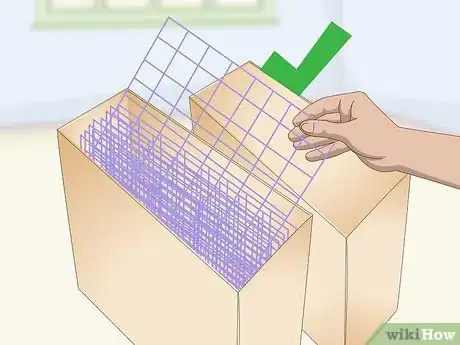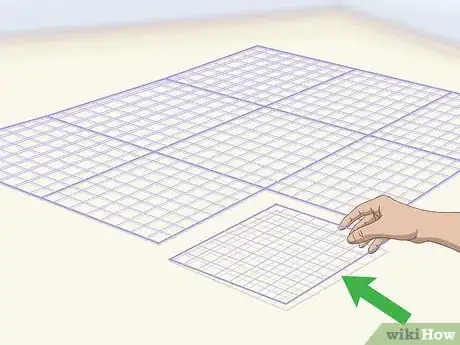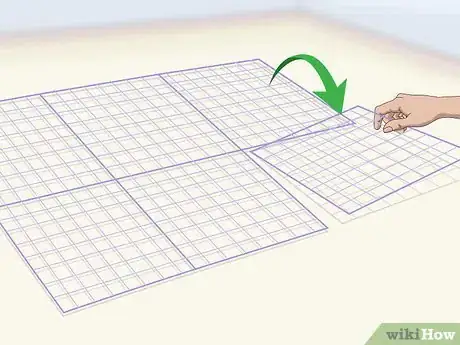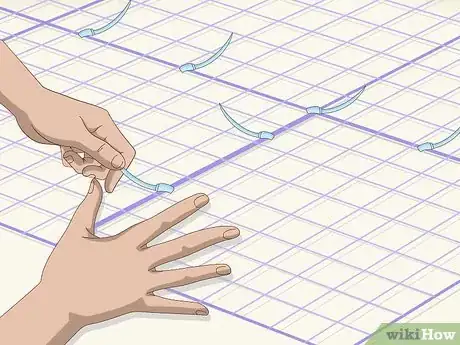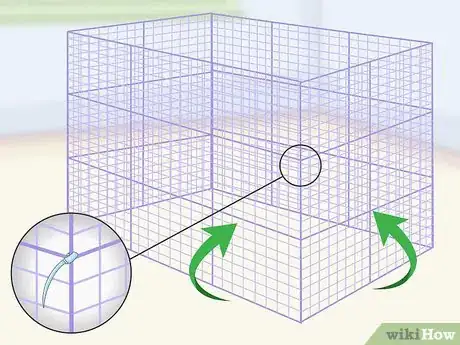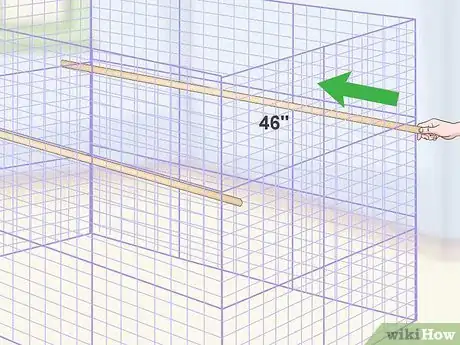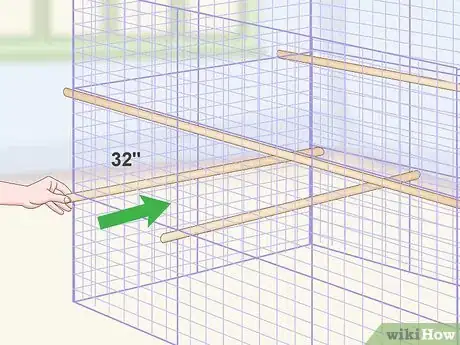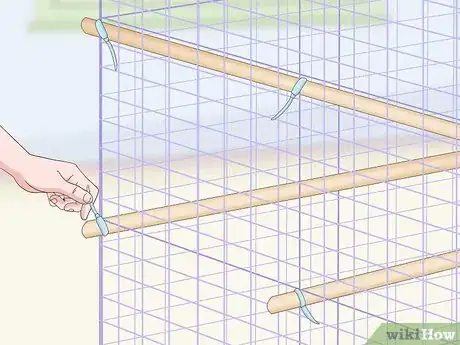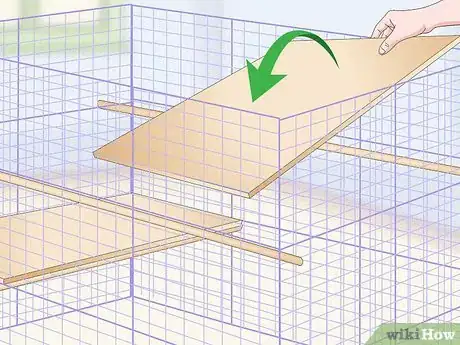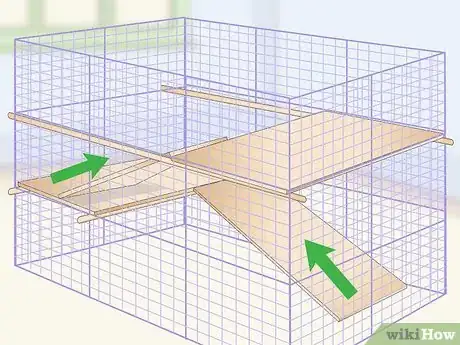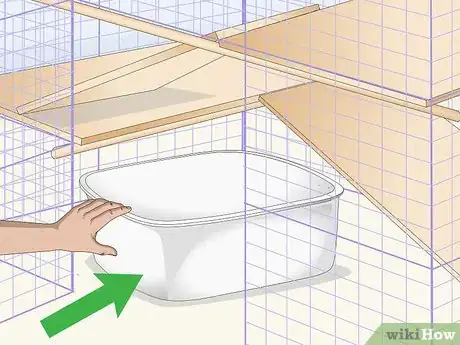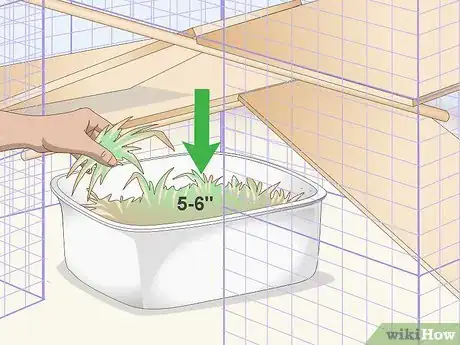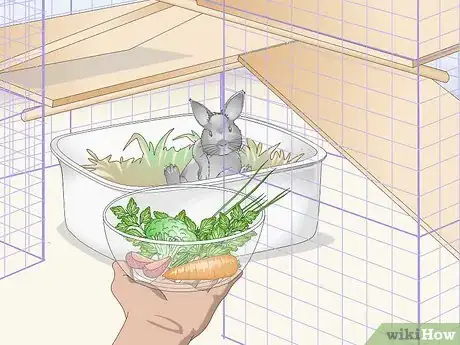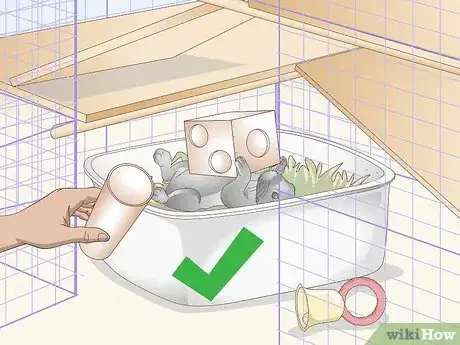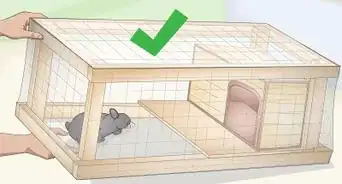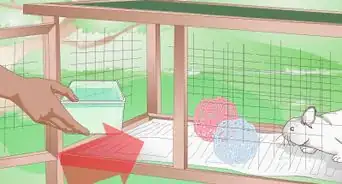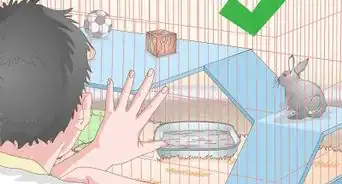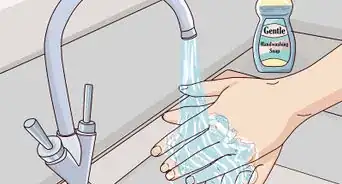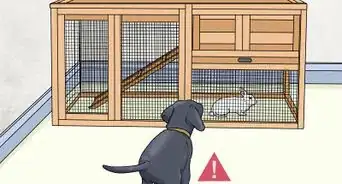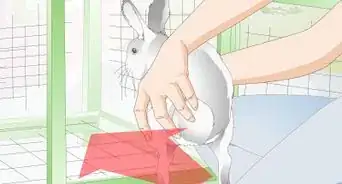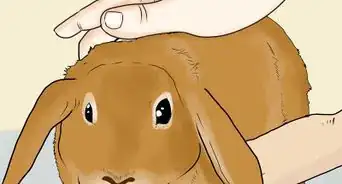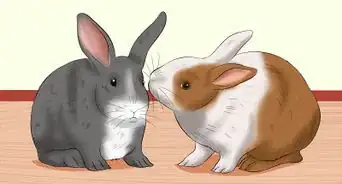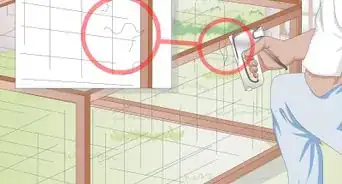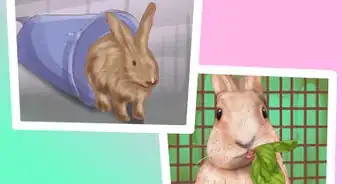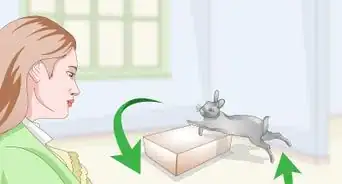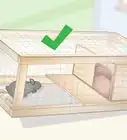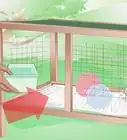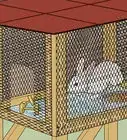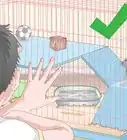This article was co-authored by wikiHow Staff. Our trained team of editors and researchers validate articles for accuracy and comprehensiveness. wikiHow's Content Management Team carefully monitors the work from our editorial staff to ensure that each article is backed by trusted research and meets our high quality standards.
This article has been viewed 35,409 times.
Learn more...
If you have a pet rabbit or are planning to get one, a rabbit cage is one of the big expenses that come with it. Luckily, an indoor rabbit cage is simple to make and offers plenty of opportunity for customization. With some wire panels and plastic cable ties, you can create a simple DIY cage with 2 plywood levels and an open floor and roof.
Steps
Creating the Cage Walls
-
1Purchase 2 boxes of wire storage cubes. You can find these at a home improvement or department store. Most packages come with about 16 wire panels and you need 30 for your cage. With 2 boxes, you'll have 32 panels.
- You can also buy wire storage cubes from online suppliers.
-
2Lay out 9 wire panels for each side wall of the cage. Start by laying down 3 wire panels in front of you in a horizontal row. Now, add 2 more horizontal rows directly above this row so that you have 1 square wall made from 9 wire panels squares. Afterward, repeat this process so you have two 3 x 3 square walls, which are the side walls of the cage.[1]
- Be sure that all of the grid parts are facing upward in the same direction.
Advertisement -
3Put down 6 wire panels to create the front and back walls of the cage. Start by creating another horizontal row of 3 wire panels. Now, add 1 more horizontal row above it to create a rectangle that is 3 wire panels long and 2 wire panels wide. Repeat this process until you have two 2 x 3 rectangles, which are the front and back walls.[2]
- Check that all of the grid parts are facing upward.
-
4Attach the wire panels together with plastic cable ties to create 4 walls. Wrap 1 cable tie around the 2 wires where the corners of each panel meet. Continue this for every corner to fasten the panels of each wall together. Afterward, the side walls should be connected by 32 cable ties in total and the front walls should be connected by 20 cable ties in total.[3]
- Don't worry about tightening the cable ties just yet—just make sure they're tight enough to hold the wire cubes together loosely.
- After you're done, check that you have 4 walls laying down flat in front of you—two 3 x 3 walls and two 2 x 3 walls.
- Rabbits often don't have an interest in cable ties, but try putting one in their current dwelling to make sure. If they start chewing it, try switching colors or using a different kind of cable tie material, such as metal.
- Cut the excess off the zip ties and make sure the pointy part faces outward—not toward the inside of the cage.
Building the Cage
-
1Connect your wall pieces to each other with cable ties. Start by connecting front wall (2 panels wide and 3 panels tall) to a side wall (3 panels wide and 3 panels tall) using cable ties. Again, connect them at the 2 wires where each corner meets. Now, place the 2 connected walls upright so that they form an "L" shape when looking down on them from above. Create another "L" from the remaining 2 walls and then attach each "L" together to create a rectangular cage.[4]
- Make sure that the panels of each wall face the same direction.
- Check that your cage is 3 panels long and 2 panels wide.
- Remove the excess portion zip ties and face them away from the cage.
-
2Align two 46 inch (120 cm) long dowels along the sides of the cage. Make sure that each dowel is slightly longer than the side walls of your cage. Slip the dowels through the top corner openings in middle panels of the front and back walls of the cage.[5]
- Use dowels made from untreated wood, such as pine.
- Make sure the dowels have a diameter of 1.125 inches (2.86 cm).
-
3Insert two 32 inch (81 cm) dowels along the front of the cage. Again, be sure the length of each dowel is a bit longer than the front wall of the cage. Put them through the 2 bottom corner openings of the frontmost middle panels of the side walls.[6]
- Make sure there is 1 panel between the length dowels and width dowels.
- Use dowels with a diameter of 1.125 inches (2.86 cm).
-
4Attach the dowels to the cage using cable ties. The first pair of dowels runs down the sides of the cage and the second down the front. Regardless, both pairs should run parallel to the tops of the wire storage panels. Wrap the twist ties around each of the dowels and the wires of the closest panels.[7]
- Be sure to tighten the twist ties so that the dowels can hold your rabbit's weight.
- Again, remove excess parts of the zip ties and make sure that pointy ends face outward away from the cage.
-
5Add 1 piece of plywood on top of each pair of dowels to create shelves. Your plywood should be 28 inches (71 cm) wide so that it extends across the width of the cage and rests on the dowels. For length, the top should be 13 inches (33 cm) long and the upper 24 inches (61 cm) long.[8]
- Keep the bottom shelf less than 1 foot (0.30 m) high so your rabbits can jump up and down them
- Never use MDF boards as they're toxic.
-
6Create a ramp between the shelves. Place a piece of plywood 4 to 5 feet (1.2 to 1.5 m) long running from the lower shelf to the top shelf. Although your rabbit will likely be able to jump from each one, giving them an alternative option is a nice touch.[9]
Furnishing Your Rabbit Cage
-
1Give your rabbit a straw tray to keep its dropping and excess food out of the cage. Fill a high-walled plastic container—about 1 foot (0.30 m) tall—with hay about halfway to the top. Afterward, place a small litter pan on one side and fill it about 1 inch (2.5 cm) deep with hardwood fuel pellets or another absorbent material.[10]
- Empty the pan into a compost bin whenever it gets soiled. Always refill it afterward.
-
2Add 5 to 6 in (13 to 15 cm) of bedding into the straw tray. You can also use hay or sawdust. However, straw is the best option as it's most comfy and holds heat in winter. Be sure to clean the bedding daily and replace soiled areas with clean material.[11]
- Don't line the cage with carpet, as it can give your rabbit bowel problems when chewed.
-
3Add a food bowl with grass, hay, fruits, and vegetables. Grass is the best food for rabbits, although hay is a great alternative. Add some fresh fruits and vegetables for treats and try to switch them up regularly to create a balanced diet. Always provide unlimited grass or hay and 256 to 512 grams (2 to 4 cups) of fresh vegetables per 2.26 kilograms (5.0 lb) of body weight.[12]
- Feed your rabbit hay alone for periods of 2 to 3 days to keep their teeth in shape.
- Provide 1 food bowl—as well as 1 water bowl—per rabbit.
- Vegetables include beet greens, radish, asparagus, broccoli, bok choy, brussels sprouts, parsley, watercress, and wheat grass.
-
4Put some toys in your cage for your rabbit to play with. Toys such as cardboard boxes and tubes are great. Try cutting some holes into a cardboard box and add some dry hay and shredded paper for your rabbit to dig through. Just be sure that your toys are rabbit-safe![13]
- Purchase toys specifically labeled for rabbits. However, toys designed for cats, parrots, or babies are usually rabbit-safe as well.
- Add some sturdy branches of orchard woods (pear, apple, cherry, plum) or commercial rabbit chews from pet stores.
- Some rabbits might even enjoy balls with a treat inside.
Community Q&A
-
QuestionDo I have to make it double-platformed?
 EmpressTigerCommunity AnswerNo, but it is recommended. With the double platform it takes up less space, and it is more comfortable for the rabbit.
EmpressTigerCommunity AnswerNo, but it is recommended. With the double platform it takes up less space, and it is more comfortable for the rabbit. -
QuestionWhere can I get wire cubes?
 Community AnswerGo to your nearest pet or farm store. You might try Amazon. Just make sure to buy the best quality.
Community AnswerGo to your nearest pet or farm store. You might try Amazon. Just make sure to buy the best quality. -
QuestionWhere can I find those wire cubes?
 Community AnswerTry a large hardware store, farm-supply store or a feed store.
Community AnswerTry a large hardware store, farm-supply store or a feed store.
Things You'll Need
- 30 wire storage cube panels
- 100 plastic cable ties
- One 28 by 13 inch (71 cm × 33 cm) piece of plywood (width x length)
- One 28 by 24 inch (71 cm × 61 cm) piece of plywood (width x length)
- Two 46 inch (120 cm) long wooden dowels
- Two 32 inch (81 cm) long wooden dowels
References
- ↑ http://breyfamily.net/bunnycage.html
- ↑ http://breyfamily.net/bunnycage.html
- ↑ http://breyfamily.net/bunnycage.html
- ↑ http://breyfamily.net/bunnycage.html
- ↑ http://www.therabbithouse.com/indoor/designing-rabbit-cage.asp
- ↑ http://www.therabbithouse.com/indoor/designing-rabbit-cage.asp
- ↑ http://breyfamily.net/bunnycage.html
- ↑ http://www.therabbithouse.com/indoor/designing-rabbit-cage.asp
- ↑ http://www.therabbithouse.com/indoor/designing-rabbit-cage.asp
